 Chef: Nomura Daisuke Website: www.atago-daigo.com Cuisine: Buddhist cuisine
Chef: Nomura Daisuke Website: www.atago-daigo.com Cuisine: Buddhist cuisine
Buddhist cuisine, better known in Japan as shyoujin-ryouri (精進料理), is a cuisine of devotion that follows the Buddhist philosophy of persistency to incorporate austere practices. Ask anyone making a culinary trip to Japan and I can guarantee you that they would have a list of restaurant dominated by sushi, kaiseki, tempura, beef and even contemporary cuisine, but Buddhist cuisine is certainly not one of them. And who can blame them when it is literally on the opposite end of the spectrum to fine dining? It therefore didn’t surprise me that there was little information available in Japanese let alone English in the public domain on our next destination, Daigo. If it wasn’t for the insistence of @Framed Eating to try this Two-Michelin starred restaurant we would have missed out on one of the highlights from our entire trip across Japan. Yes, you heard me correctly… it was unbelievably good and personally I thought they deserved the almighty three star status.
 Nomura Yoshiko, who founded Daigo restaurant near Daigo-ji temple in 1950, remained as the okami (female lady of the house / supervisor) of the establishment until the restaurant relocated to a more modern location next to Seisho-ji temple at the foot of Mt. Atago in Tokyo. The current premises of the restaurant works perfectly well and you still get that genuine feeling of entering an old temple despite the modern surrounding. Daigo continues to be a family affair where Nomura Satoko oversee’s the guests arrival as the current okami, supported by her husband Nomura Masao (president) and three sons who run the restaurant that are Nomura Yusuke (restaurant manager), Nomura Tadasuke (office manager) and Nomura Daisuke (head chef).
Nomura Yoshiko, who founded Daigo restaurant near Daigo-ji temple in 1950, remained as the okami (female lady of the house / supervisor) of the establishment until the restaurant relocated to a more modern location next to Seisho-ji temple at the foot of Mt. Atago in Tokyo. The current premises of the restaurant works perfectly well and you still get that genuine feeling of entering an old temple despite the modern surrounding. Daigo continues to be a family affair where Nomura Satoko oversee’s the guests arrival as the current okami, supported by her husband Nomura Masao (president) and three sons who run the restaurant that are Nomura Yusuke (restaurant manager), Nomura Tadasuke (office manager) and Nomura Daisuke (head chef).
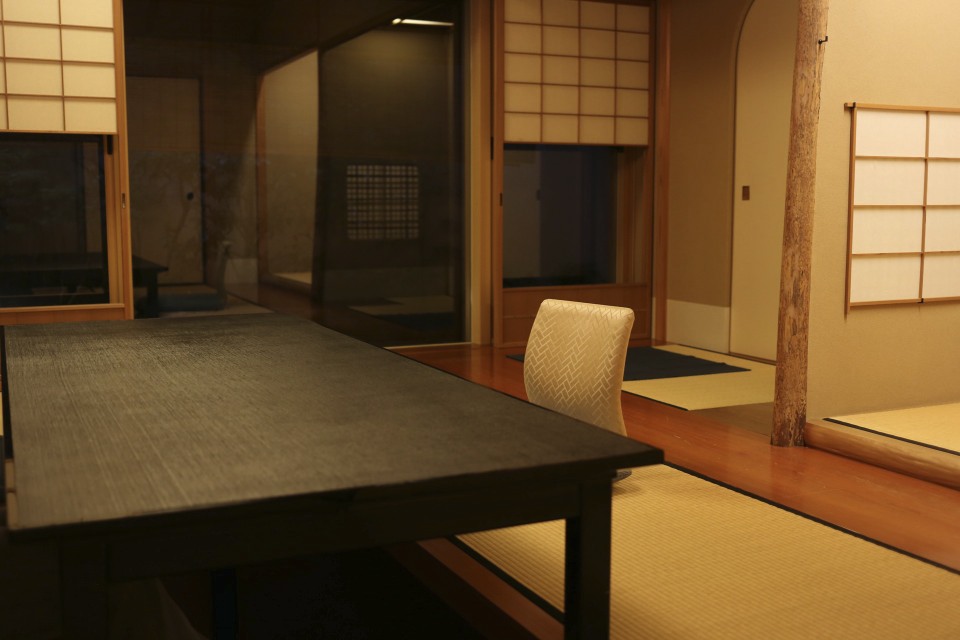 Unlike traditional shyoujin ryori which can often be very basic and modest in portion, Daigo offers three alternative kaiseki-styled menus – the dearest being a mere 19,000 yen – with carefully selected ingredients directly from the farmers / producers and Tsukiji Vegetable Market. This concept appears to be paying dividends as they have started to attract new devotees across Japan who return during different seasons. The menu here is also designed in a way that allows you to appreciate the tanmi (淡味) or the subtlety of flavours, progressing from lighter preparations to much bolder flavours, allowing you to distinguish the essence of each main ingredient.
Unlike traditional shyoujin ryori which can often be very basic and modest in portion, Daigo offers three alternative kaiseki-styled menus – the dearest being a mere 19,000 yen – with carefully selected ingredients directly from the farmers / producers and Tsukiji Vegetable Market. This concept appears to be paying dividends as they have started to attract new devotees across Japan who return during different seasons. The menu here is also designed in a way that allows you to appreciate the tanmi (淡味) or the subtlety of flavours, progressing from lighter preparations to much bolder flavours, allowing you to distinguish the essence of each main ingredient.
 Word of warning though for those who are not used to Japanese customs. You will be required to take off your shoes at the entrance before you are shown to one of the eight private rooms available on the premises. All the rooms have tatami floors with a view over their own private Japanese garden. Impressively there was an almost complete absence of any noise from the neighbouring rooms given there were only a couple of shōji’s (rice paper wall) separating us.
Word of warning though for those who are not used to Japanese customs. You will be required to take off your shoes at the entrance before you are shown to one of the eight private rooms available on the premises. All the rooms have tatami floors with a view over their own private Japanese garden. Impressively there was an almost complete absence of any noise from the neighbouring rooms given there were only a couple of shōji’s (rice paper wall) separating us.
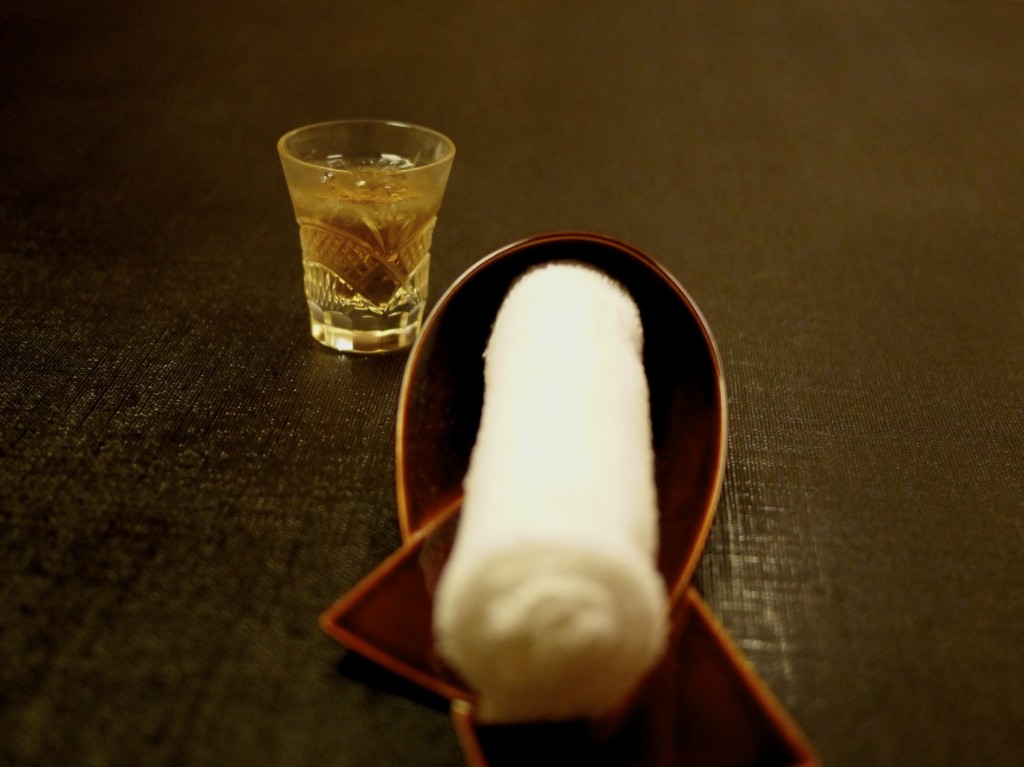 Our reservation fell on a rather hot and humid September evening and the ice chilled apperitif or shokuzenshu (食前酒) of the Umeshu plum wine (梅酒) with a scented wet napkin to freshen up was a very welcomed gesture to our arrival.
Our reservation fell on a rather hot and humid September evening and the ice chilled apperitif or shokuzenshu (食前酒) of the Umeshu plum wine (梅酒) with a scented wet napkin to freshen up was a very welcomed gesture to our arrival.
 Soon after settling in and absorbing the environment the shoji slid open and Nomura-san personally came to pour us some sake in a ceremonial wide-mouthed cup, also known as Sakazuki (盃). As expected from a Junmai Daiginjyo, it was rather delicious and left us wanting more.
Soon after settling in and absorbing the environment the shoji slid open and Nomura-san personally came to pour us some sake in a ceremonial wide-mouthed cup, also known as Sakazuki (盃). As expected from a Junmai Daiginjyo, it was rather delicious and left us wanting more.
 As the sake was being poured, another waitress proceeded to serving us our Zensai (前菜), otherwise known as the Starter, on a beautiful lacquered tray with a pair of chopsticks that we were encouraged to take home after our meal.
As the sake was being poured, another waitress proceeded to serving us our Zensai (前菜), otherwise known as the Starter, on a beautiful lacquered tray with a pair of chopsticks that we were encouraged to take home after our meal.
 As we were technically still in the fall of autumn, our first course was the chef’s interpretation of Tsukimi Dango (月見団子), a typical dumpling served for the moon-viewing festival (Tsukimi) that dates back to the Heian period, roughly a thousand years ago. Four lightly fried dumplings of Edamame, Corn, Rice and Sesame were served that were all distinctly flavoursome as well as crispy, warm and void of any excess oil. Not a bad start at all.
As we were technically still in the fall of autumn, our first course was the chef’s interpretation of Tsukimi Dango (月見団子), a typical dumpling served for the moon-viewing festival (Tsukimi) that dates back to the Heian period, roughly a thousand years ago. Four lightly fried dumplings of Edamame, Corn, Rice and Sesame were served that were all distinctly flavoursome as well as crispy, warm and void of any excess oil. Not a bad start at all.
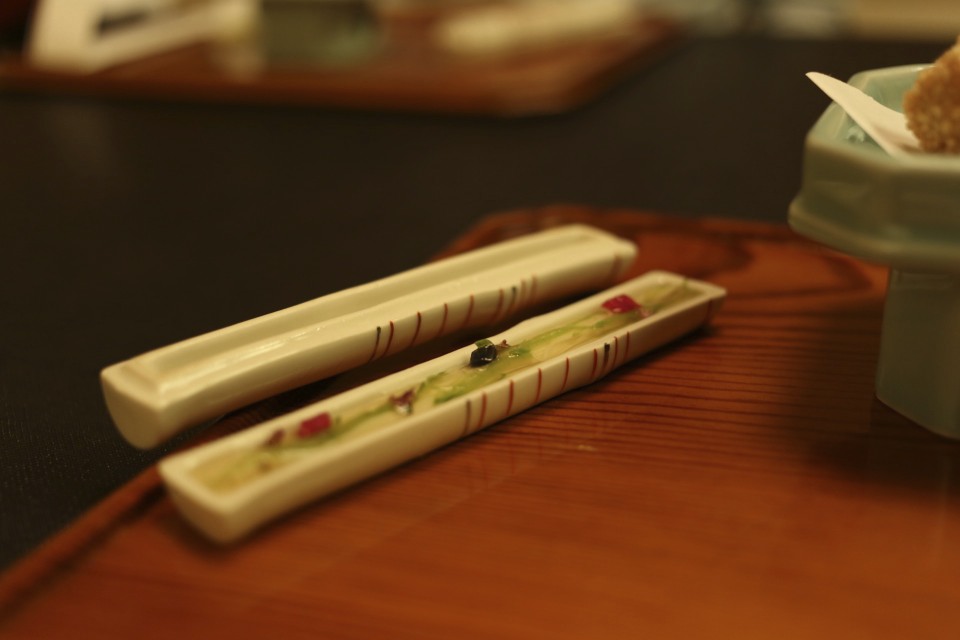 The dumplings came with a Kotsuke (小附), a small supplement dish called Shikisaikurouyose (色彩九郎寄せ) and Suizenjinori (水前寺海苔) served in a long ceramic case. It was essentially a herbaceious gel of dashi stock containing shiso (perilla) leaves and seaweed from Suizen-ji temple. The strong sweet and spicy flavour really drew the clean flavour of the dashi.
The dumplings came with a Kotsuke (小附), a small supplement dish called Shikisaikurouyose (色彩九郎寄せ) and Suizenjinori (水前寺海苔) served in a long ceramic case. It was essentially a herbaceious gel of dashi stock containing shiso (perilla) leaves and seaweed from Suizen-ji temple. The strong sweet and spicy flavour really drew the clean flavour of the dashi.
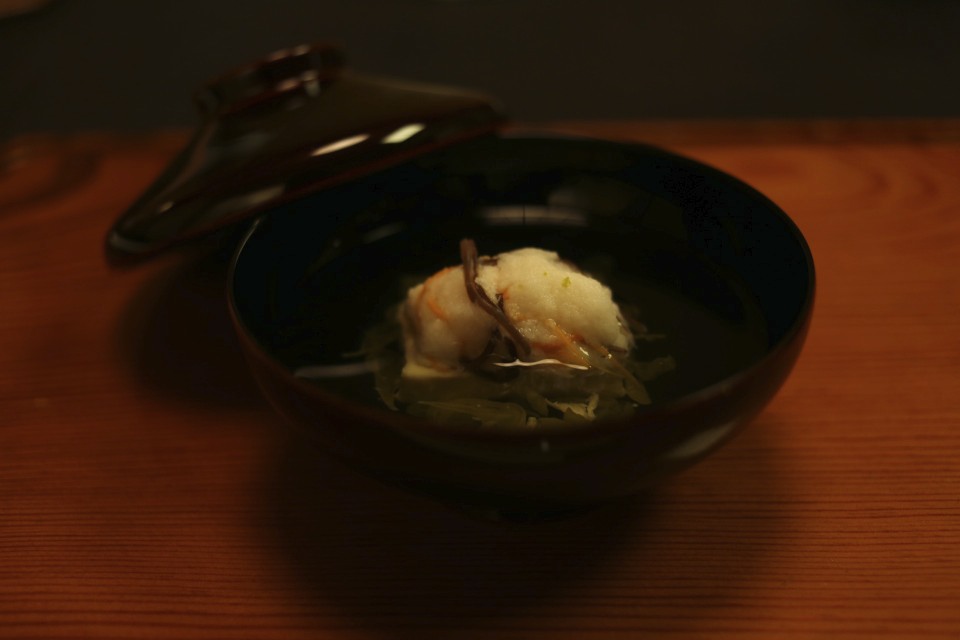 Next was the clear soup course or Osuimono (御吸物), an aromatic Kaburamushi (蕪蒸し), essentially a turnip that had been steamed, peeled and grated before reassembling it into a small ball and serving it in a clear soup with the young leaves of Japanese pepper, kinome (木の芽), and yuba (tofu skin). Whilst Kaburamushi is traditionally made with white fish flesh and prawn in Kyoto, this one was purely vegetarian and was far superior to any kaburamushi I’ve previously. It had a soft texture and distinct but subtle flavour of turnip.
Next was the clear soup course or Osuimono (御吸物), an aromatic Kaburamushi (蕪蒸し), essentially a turnip that had been steamed, peeled and grated before reassembling it into a small ball and serving it in a clear soup with the young leaves of Japanese pepper, kinome (木の芽), and yuba (tofu skin). Whilst Kaburamushi is traditionally made with white fish flesh and prawn in Kyoto, this one was purely vegetarian and was far superior to any kaburamushi I’ve previously. It had a soft texture and distinct but subtle flavour of turnip.
 We couldn’t resist trying at least one sake so we opted for the recommended Daiginjyo from Niigata.
We couldn’t resist trying at least one sake so we opted for the recommended Daiginjyo from Niigata.
 The filler course to tie to the next dish, also known as an Oshinogi (お凌ぎ), was an assortment of Vegetable Sushi (野菜寿司) made from Green pepper (ピーマン) with black sesame and salt crystals, Bamboo shoot – Takenoko (筍), Shiitake mushroom (椎茸), Fermented seaweed and Cucumber – Kappamaki (河童巻). Each sushi was remarkably delicious and varied in sweetness, and seasoning to complement each ingredient. It took us by surprise as we had low expectation from this course because one would normally associate sushi with fish. Nomura-san explained this dish was replaced with a soba course in summer to suit the season.
The filler course to tie to the next dish, also known as an Oshinogi (お凌ぎ), was an assortment of Vegetable Sushi (野菜寿司) made from Green pepper (ピーマン) with black sesame and salt crystals, Bamboo shoot – Takenoko (筍), Shiitake mushroom (椎茸), Fermented seaweed and Cucumber – Kappamaki (河童巻). Each sushi was remarkably delicious and varied in sweetness, and seasoning to complement each ingredient. It took us by surprise as we had low expectation from this course because one would normally associate sushi with fish. Nomura-san explained this dish was replaced with a soba course in summer to suit the season.
 The next dish, the Hassun (八寸) is perhaps the most poetic and constrained course in a kaiseki meal. The tray used to serve the course is always made of plain cedar, and it is traditionally the course where the master chef and the customer toast with a cup of sake. The tray typically contains two types of food representing “mountain” and “sea” that depict and celebrate the current season. The food is arranged across the tray in tiny piles to create contrasts of color, shape, texture, and seasoning. It is been generally recognised in Japan that a person with sensitivity to the changing season is one that possesses talent.
The next dish, the Hassun (八寸) is perhaps the most poetic and constrained course in a kaiseki meal. The tray used to serve the course is always made of plain cedar, and it is traditionally the course where the master chef and the customer toast with a cup of sake. The tray typically contains two types of food representing “mountain” and “sea” that depict and celebrate the current season. The food is arranged across the tray in tiny piles to create contrasts of color, shape, texture, and seasoning. It is been generally recognised in Japan that a person with sensitivity to the changing season is one that possesses talent.
 We started the Hassun with the “sea” item of Atagoshigure (愛宕時雨), where essentially hijiki (brown sea vegetable) and gluten (extracted from wheat) had been delicately seasoned with soy sauce. The texture was not too dissimilar to that of minced chicken and just melted in your mouth. I was worried about the soy sauce overpowering the flavour but that was certainly not the case here. Who needs meat when vegetarian food can be this good? Impressive.
We started the Hassun with the “sea” item of Atagoshigure (愛宕時雨), where essentially hijiki (brown sea vegetable) and gluten (extracted from wheat) had been delicately seasoned with soy sauce. The texture was not too dissimilar to that of minced chicken and just melted in your mouth. I was worried about the soy sauce overpowering the flavour but that was certainly not the case here. Who needs meat when vegetarian food can be this good? Impressive.
 The item representing the “mountain” was the Houzuki Yamamomo (鬼灯山桃) which was a mountain peach encased in a layer of mountain peach jelly and beautifully presented in Japanese lantern leaves (houzuki). I expected the flavours to be rather tart but instead it was bordering on sweet and perhaps my least favourite item in the course.
The item representing the “mountain” was the Houzuki Yamamomo (鬼灯山桃) which was a mountain peach encased in a layer of mountain peach jelly and beautifully presented in Japanese lantern leaves (houzuki). I expected the flavours to be rather tart but instead it was bordering on sweet and perhaps my least favourite item in the course.
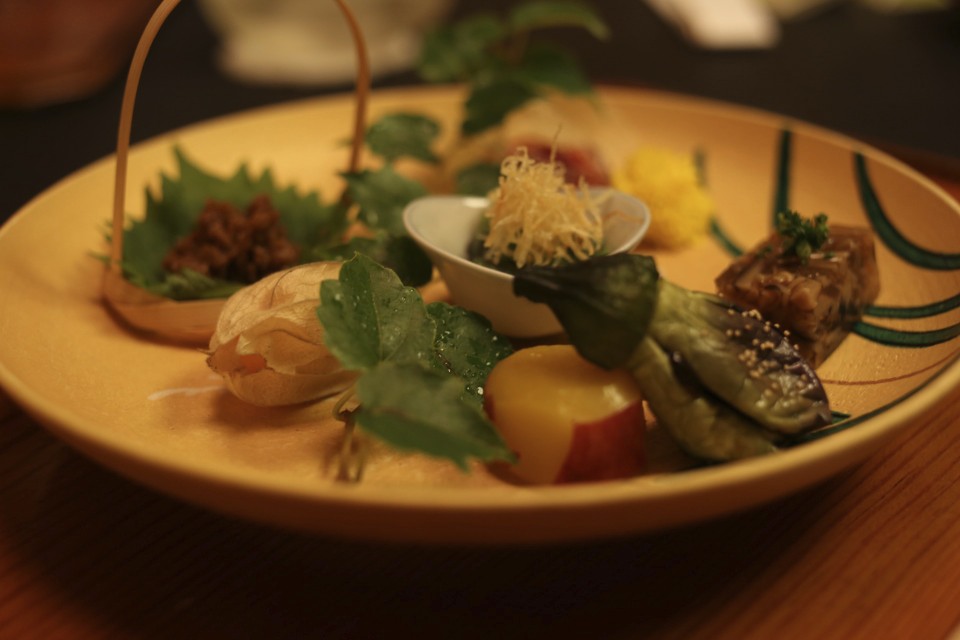 We continued with the Take ni kogori (茸煮凝り), which was the gelatinated mushroom cube on the right, followed by Konasu Dengaku (小茄子田楽), essentially a small but flavoursome aubergine that had been broiled in a sweet and savoury miso glaze, resting on mountain potato. We finished with the Mizutama Ohitashi (水玉草お浸し) which is a genus of the whillowherb family that had been cooked in a buckwheat soba stock and topped with crispy tempura flakes of wheat. The chef definitely knew how to draw out the flavour of each ingredient whilst respecting them as well. The cooking thus far was impressive and beyond a two-star level.
We continued with the Take ni kogori (茸煮凝り), which was the gelatinated mushroom cube on the right, followed by Konasu Dengaku (小茄子田楽), essentially a small but flavoursome aubergine that had been broiled in a sweet and savoury miso glaze, resting on mountain potato. We finished with the Mizutama Ohitashi (水玉草お浸し) which is a genus of the whillowherb family that had been cooked in a buckwheat soba stock and topped with crispy tempura flakes of wheat. The chef definitely knew how to draw out the flavour of each ingredient whilst respecting them as well. The cooking thus far was impressive and beyond a two-star level.
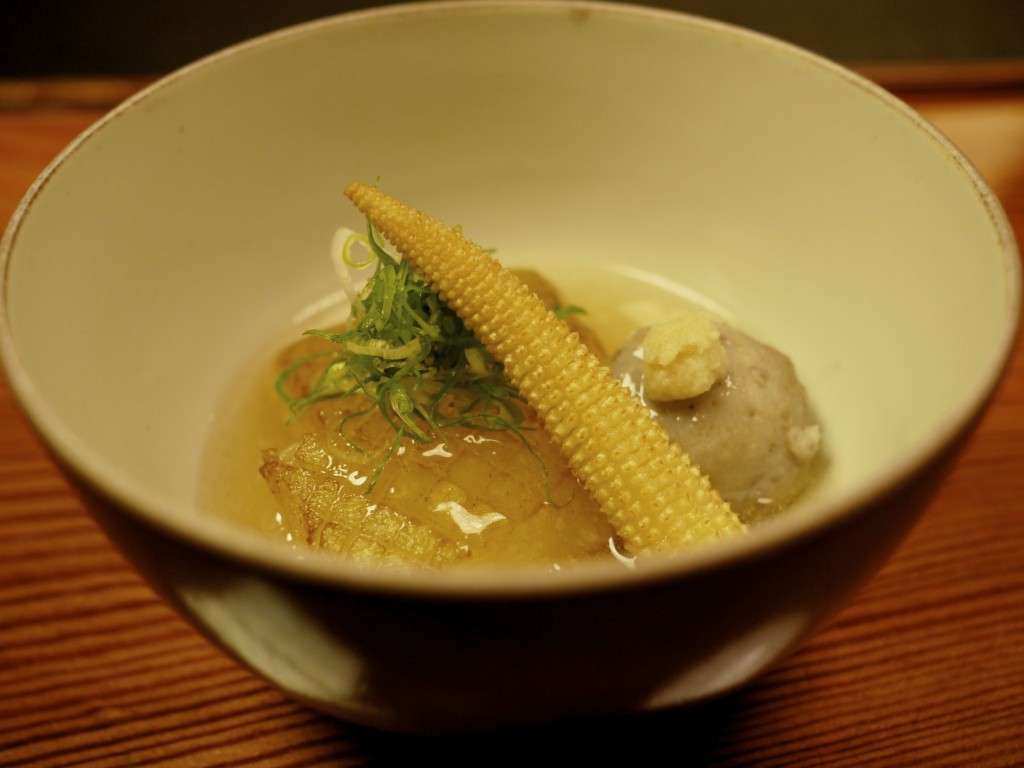 The Nimono (煮物) or simmered dish course was a Tougan agedashi (冬瓜揚げ出し) presented in a ceramic bowl covered with a lid. The fragrant aroma that wafted out was sensational and put us under a spell. The dish contained fried winter melon that was steeped in dashi stock and served with rice cake balls and mountain potato, and topped with grated ginger, spring onion and baby corn. The slight heat from the ginger, fragrance of the spring onion and the sticky texture of the rice ball – all came together with the thick dashi sauce. What a phenomenal dish!
The Nimono (煮物) or simmered dish course was a Tougan agedashi (冬瓜揚げ出し) presented in a ceramic bowl covered with a lid. The fragrant aroma that wafted out was sensational and put us under a spell. The dish contained fried winter melon that was steeped in dashi stock and served with rice cake balls and mountain potato, and topped with grated ginger, spring onion and baby corn. The slight heat from the ginger, fragrance of the spring onion and the sticky texture of the rice ball – all came together with the thick dashi sauce. What a phenomenal dish!
 Our Agemono (揚物), or deep fried course, was Daigo’s Shyoujin-age (精進揚げ) consisting of a variety of tempura from maitake (hen-of-the-woods mushroom), shikakui-mame (winged bean), sweet pumpkin, tofu and shallots. The tempura here was far more interesting and well balanced in texture and flavours than Raku-tei. I particularly liked the rice pop corn that was salty and packed with so much flavour.
Our Agemono (揚物), or deep fried course, was Daigo’s Shyoujin-age (精進揚げ) consisting of a variety of tempura from maitake (hen-of-the-woods mushroom), shikakui-mame (winged bean), sweet pumpkin, tofu and shallots. The tempura here was far more interesting and well balanced in texture and flavours than Raku-tei. I particularly liked the rice pop corn that was salty and packed with so much flavour.
 There was a significant pause before Nomura-san came back with our next course. However, contrary to what we expected based on the copy of the menu we were given, a special course of Japanese fig or Ichijiku (無花果) was brought to us on the house. The fig had been prepared in a sakamushi style, that is steamed with sake, and served with a white miso glaze on top. It was by far the best fig dish I have ever tried with a beaitful marriage of sweet and savoury flavours and a melting texture to die for. We were left speechless as Nomura-san came back to collect our empty dishes. We must have looked like a bunch of guppies.
There was a significant pause before Nomura-san came back with our next course. However, contrary to what we expected based on the copy of the menu we were given, a special course of Japanese fig or Ichijiku (無花果) was brought to us on the house. The fig had been prepared in a sakamushi style, that is steamed with sake, and served with a white miso glaze on top. It was by far the best fig dish I have ever tried with a beaitful marriage of sweet and savoury flavours and a melting texture to die for. We were left speechless as Nomura-san came back to collect our empty dishes. We must have looked like a bunch of guppies.
 The Shiizakana (強肴) is traditionally served to customers after the fried dish as a relish to further enjoy with the sake of choice. On this occasion we were served a Matsutake Mizoreae (松茸霙和え), that is pine mushroom prepared with grated daikon radish, and Kaki Shishitou (柿獅子唐) which were slithers of persimon and slightly hot shishitou peppers. I’m not the biggest fan of matsutake mushrooms but this wasn’t too bad as far as it went.
The Shiizakana (強肴) is traditionally served to customers after the fried dish as a relish to further enjoy with the sake of choice. On this occasion we were served a Matsutake Mizoreae (松茸霙和え), that is pine mushroom prepared with grated daikon radish, and Kaki Shishitou (柿獅子唐) which were slithers of persimon and slightly hot shishitou peppers. I’m not the biggest fan of matsutake mushrooms but this wasn’t too bad as far as it went.
 Our palate cleanser, or Hashiarai (箸洗) was served in a beautiful ceramic cup that contained…
Our palate cleanser, or Hashiarai (箸洗) was served in a beautiful ceramic cup that contained…
 … Chikushi Konbu (竹紙昆布) which was a soup made of a luxurious konbu (kelp that has been shaved manually by hand to make it extremely thin to 0.05mm), garnished with slithers of the konbu itself and puffed rice balls. It was very soothing and aromatic again. Despite having quite a few dishes we felt energised at this point as the food had been light, aromatic and harmonious in progression.
… Chikushi Konbu (竹紙昆布) which was a soup made of a luxurious konbu (kelp that has been shaved manually by hand to make it extremely thin to 0.05mm), garnished with slithers of the konbu itself and puffed rice balls. It was very soothing and aromatic again. Despite having quite a few dishes we felt energised at this point as the food had been light, aromatic and harmonious in progression.
 The Gohan (御飯) or rice dish came on a lacquered tray and was our ultimate savoury dish of the evening. It contained…
The Gohan (御飯) or rice dish came on a lacquered tray and was our ultimate savoury dish of the evening. It contained…
 … a bowl of Nameko Zousui (なめこ雑炊), basically a rice porridge dish prepared in a stock made from nameko mushroom served with gooey nameko and enoki mushrooms. As the evening was getting cooler in the Autumn evenings this was the perfect dish to warm your core temperature up. The food here was not only delicious but also thoughtful. The concentrated flavour of mushrooms was stunning and the lingering flavour in our mouths delightful. This was indeed what Japanese people call soul food.
… a bowl of Nameko Zousui (なめこ雑炊), basically a rice porridge dish prepared in a stock made from nameko mushroom served with gooey nameko and enoki mushrooms. As the evening was getting cooler in the Autumn evenings this was the perfect dish to warm your core temperature up. The food here was not only delicious but also thoughtful. The concentrated flavour of mushrooms was stunning and the lingering flavour in our mouths delightful. This was indeed what Japanese people call soul food.
 To go with the porridge we had some condiments, Kou no mono (香の物), that included an earthy Yamagobou (山ごぼう) or mountain burdock, Sainome daikon (賽の目大根) or sliced daikon radish, and Bainiku (梅肉) which was a tart paste made from plum.
To go with the porridge we had some condiments, Kou no mono (香の物), that included an earthy Yamagobou (山ごぼう) or mountain burdock, Sainome daikon (賽の目大根) or sliced daikon radish, and Bainiku (梅肉) which was a tart paste made from plum.
 Our meal finished with a couple of sweet dishes starting with the Mizunomono (水の物) which on this occasion was an unbelievably juicy and sweet slice of melon and grapes and…
Our meal finished with a couple of sweet dishes starting with the Mizunomono (水の物) which on this occasion was an unbelievably juicy and sweet slice of melon and grapes and…
 … we had a cup of the best cold red bean soup with mochi – Shiratama zenzai (白玉善哉) – I have ever had the pleasure of eating. The flavour of the red bean had been further drawn out with kurozatou or black sugar but without making it sickeningly sweet.
… we had a cup of the best cold red bean soup with mochi – Shiratama zenzai (白玉善哉) – I have ever had the pleasure of eating. The flavour of the red bean had been further drawn out with kurozatou or black sugar but without making it sickeningly sweet.
We came with little expectation and left speechless. Shoujin ryouri has countless limitations in its cooking methods and is intertwined with Japanese traditions, culture and arts. This was clearly demonstrated at Daigo by the sense of season in the cooking as well as the selection of crockery used for plating and presentation. In a culinary age that could be perhaps described as gluttony from the abudance of food, a cuisine following the austere discipline of Buddhism is a fresh breath of air. The only thing I didn’t agree was the star rating bestowed by Michelin. This was far superior to many Three-starred establishments we had collectively visited. If Daigo isn’t on your list then I would strongly urge you to add it.
